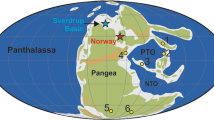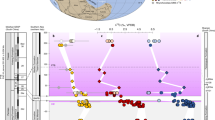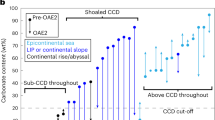Abstract
The mass extinction event at the Cretaceous/Palaeogene boundary 65.5 Myr ago has been widely attributed to the Chicxulub impact1,2, but the mechanisms of extinction remain debated1,3,4,5,6. In the oceans, near-surface planktonic foraminifera suffered severe declines, in contrast to the relatively high survival rates of bottom-dwelling benthic foraminifera7. The vapour produced by an impact into Chicxulub’s target rocks, which include sulphate-rich anhydrite, could have led to global acid rain, which can explain the pattern of oceanic extinctions4,5. However, it has been suggested that most of the sulphur in the target rocks would have been released as sulphur dioxide and would have stayed in the stratosphere for a long time6. Here we show, from impact experiments into anhydrite at velocities exceeding 10 km s−1, that sulphur trioxide dominates over sulphur dioxide in the resulting vapour cloud. Our experiments suggest that the Chicxulub impact released a huge quantity of sulphur trioxide into the atmosphere, where it would have rapidly combined with water vapour to form sulphuric acid aerosol particles. We also find, using a theoretical model of aerosol coagulation following the Chicxulub impact, that larger silicate particles ejected during the impact efficiently scavenge sulphuric acid aerosol particles and deliver the sulphuric acid to the surface within a few days. The rapid surface deposition of sulphuric acid would cause severe ocean acidification and account for preferential extinction of planktonic over benthic foraminifera.
This is a preview of subscription content, access via your institution
Access options
Subscribe to this journal
Receive 12 print issues and online access
$259.00 per year
only $21.58 per issue
Buy this article
- Purchase on Springer Link
- Instant access to full article PDF
Prices may be subject to local taxes which are calculated during checkout



Similar content being viewed by others
References
Alvarez, L. W., Alvarez, W., Asaro, F. & Michel, H. V. Extraterrestrial cause for the Cretaceous–Tertiary extinction. Science 208, 1085–1108 (1980).
Schulte, P. et al. The Chicxulub asteroid impact and mass extinction at the Cretaceous–Paleogene boundary. Science 327, 1214–1218 (2010).
Wolbach, W. S. et al. Global fire at the Cretaceous–Tertiary boundary. Nature 334, 665–669 (1988).
Pope, K. O., Baines, K. H., Ocampo, A. C. & Ivanov, B. A. Impact winter at the Cretaceous/Tertiary extinctions: Results of a Chicxulub asteroid impact model. Earth Plant. Sci. Lett. 128, 719–725 (1994).
Pierazzo, E., Hahmann, A. N. & Sloan, L. C. Chicxulub and climate: Radiative perturbations of impact-produced S-bearing gases. Astrobiology 3, 99–118 (2003).
D’Hondt, S. et al. Surface-water acidification and extinction at the Cretaceous–Tertiary boundary. Geology 22, 983–986 (1994).
Sigurdsson, H. et al. Geochemical constraints on source region of Cretaceous/Tertiary impact glasses. Nature 353, 839–842 (1991).
Maruoka, T. & Koeberl, C. Acid-neutralizing scenario after the Cretaceous–Tertiary impact event. Geology 31, 489–492 (2003).
Vajda, V. et al. Indication of global deforestation at the Cretaceous– Tertiary boundary by New Zealand Fern Spike. Science 294, 1700–1702 (2001).
Pope, K. O., Baines, K. H., Ocampo, A. C. & Ivanov, B. A. Energy, volatile production and climate effects of the Chicxulub Cretaceous/Tertiary impact. J. Geophys. Res. 102, 21645–21664 (1997).
Ohno, S. et al. Sulfur chemistry in laser-simulated impact vapor clouds: Implications for the K/T impact event. Earth Planet. Sci. Lett. 218, 347–361 (2004).
Kadono, T. et al. Impact experiments with a new technique for acceleration of projectiles to velocities higher than Earth’s escape velocity of 11.2 km/s. J. Geophys. Res. 115, E04003 (2010).
Ohno, S. et al. Direct measurements of impact devolatilization of calcite using a laser gun. Geophys. Res. Lett. 35, L13202 (2008).
Kadono, T. et al. in Proc. Shock Compression of Condensed Matter—2011 (eds Elert, M. L., Buttler, W. T., Borg, J. P., Jordan, J. L. & Vogler, T. J.) Flyer acceleration by high-power laser and impact experiments at velocities higher than 10 km/s. 847–850 (American Institute of Physics, 2012).
Ohno, S. et al. in Proc. Shock Compression of Condensed Matter—2011 (eds Elert, M. L., Buttler, W. T., Borg, J. P., Jordan, J. L. & Vogler, T. J.) Direct measurement of chemical composition of SOx in impact vapor using a laser gun. 851–854 (American Institute of Physics, 2012).
Yang, W. & Ahrens, T. J. Shock vaporization of anhydrite and global effects of the K/T bolide. Earth Plant. Sci. Lett. 156, 125–140 (1998).
Trinquier, A., Birck, J-L. & Allégre, C. J. The nature of the K/T impactor. A 54Cr reappraisal. Earth Plant. Sci. Lett. 241, 780–788 (2006).
Anderson, W. W. & Ahrens, T. J. in Proc. Shock Compression of Condensed Matter—1997 (eds Schmidt, S. C., Dandekar, D. P. & Forbes, J. W.) Shock wave equations of state of chondritic meteorites. 115–118 (American Institute of Physics, 1998).
Ivanov, B. A. et al. Degassing of sedimentary rocks due to Chicxulub impact: Hydrocode and physical simulations. Geol. Soc. Am. Special Paper 307, 125–139 (1996).
Toon, O. B. et al. Environmental perturbations caused by the impacts of asteroids and comets. Rev. Geophys. 35, 41–78 (1997).
Pope, K. O. Impact dust not the cause of the Cretaceous–Tertiary mass extinction. Geology 30, 99–102 (2002).
Pierazzo, E., Kring, D. A. & Melosh, H. J. Hydrocode simulations of the Chicxulub impact event and the production of climatically active gases. J. Geophys. Res. 103, 28606–28625 (1998).
Smit, J. The global stratigraphy of the Cretaceous–Tertiary boundary impact ejecta. Annu. Rev. Earth Planet. Sci. 27, 75–113 (1999).
Seinfeld, J. H. & Pandis, S. N. Atmospheric Chemistry and Physics: From Air Pollution to Climate Change (Wiley, (1998).
Alegret, L., Thomas, E. & Lohmann, K. C. End-Cretaceous marine mass extinction not caused by productivity collapse. Proc. Natl Acad. Sci. USA 109, 728–732 (2012).
Brett, R. The Cretaceous-Tertiary extinction: A lethal mechanism involving anhydrite target rocks. Geochim. Cosmochim. Acta. 56, 3603–3606 (1992).
Lyons, J. R. & Ahrens, T. J. in High-Pressure Shock Compression of Solids V (eds Davison, L., Horie, Y. & Sekine, T.) Terrestrial acidification at the K/T boundary. 181–197 (Springer, (2003).
Misra, S. & Froelich, P. N. Lithium isotope history of Cenozoic seawater: Changes in silicate weathering and reverse weathering. Science 335, 818–823 (2012).
Oliver, L. et al. Silicate weathering rates decoupled from the 87Sr/86Sr ratio of the dissolved load during Himalayan erosion. Chem. Geol. 201, 119–139 (2003).
Preisinger, A. et al. Cretaceous–Tertiary profile, rhythmic deposition, and geomagnetic polarity reversals of marine sediments near Bjala, Bulgaria. Geol. Soc. Am. Special Paper 356, 213–229 (2002).
Acknowledgements
The authors thank the GXII technical crew for their support. This research was supported in part by the Japanese Ministry of Education, Science, Sports and Culture (MEXT) and by a joint research project of the Institute of Laser Engineering, Osaka University. This study has been supported by Grant-in-Aid 2424407 and 25120006. The authors also thank late G. Igarashi for discussions during the early phase of this study.
Author information
Authors and Affiliations
Contributions
S.O., T.K., T.M. and S.S. conceived the study and wrote the paper. S.O., T.K., K.K., T.H., T. Sakaiya, K.S., Y.H., T. Sano, T.W., K.O. and S.S. carried out the experimental work using the GXII and analysed the results. S.O. and S.S. created the sweeping out model and carried out the calculations.
Corresponding author
Ethics declarations
Competing interests
The authors declare no competing financial interests.
Supplementary information
Supplementary Information
Supplementary Information (PDF 488 kb)
Rights and permissions
About this article
Cite this article
Ohno, S., Kadono, T., Kurosawa, K. et al. Production of sulphate-rich vapour during the Chicxulub impact and implications for ocean acidification. Nature Geosci 7, 279–282 (2014). https://doi.org/10.1038/ngeo2095
Received:
Accepted:
Published:
Issue Date:
DOI: https://doi.org/10.1038/ngeo2095
This article is cited by
-
Pelagic responses to oceanic anoxia during the Carnian Pluvial Episode (Late Triassic) in Panthalassa Ocean
Scientific Reports (2023)
-
Chicxulub impact winter sustained by fine silicate dust
Nature Geoscience (2023)
-
The Chicxulub impact and its environmental consequences
Nature Reviews Earth & Environment (2022)
-
Oceanic anoxic events in the Earth’s geological history and signature of such event in the Paleocene-Eocene Himalayan foreland basin sediment records of NW Himalaya, India
Arabian Journal of Geosciences (2022)
-
Two-step extinction of Late Cretaceous marine vertebrates in northern Gulf of Mexico prolonged biodiversity loss prior to the Chicxulub impact
Scientific Reports (2020)



